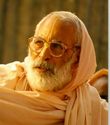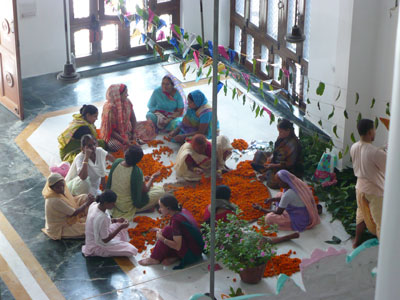
On August 16th Srila Narayana Maharaja went to Haridwar, a city of spiritual significance, situated one hour south of Rishikesa. There, the Hare Krsna Hare Rama Seva Trust, founded by Mr. Somnath and his three brothers and his wife Poonam, had constructed a guesthouse called ‘Madhavi-kunja’. They offered this facility to Srila Narayana Maharaja, who kindly accepted it as his new temple and renamed it ‘Sri Sri Radha-Madhava Gaudiya Math’. The temple was officially opened at a two-day ceremony, August 18th -19th, at which time Srila Narayana Maharaja installed the new temple Deities. About a hundred-fifty devotees from Mathura, Vrndavana and Delhi were present to take part in the festivities.
Early in the morning on the 18th, the devotees began preparing for the official temple opening. They cleaned, cooked, decorated, made garlands, and set up all the paraphernalia for the fire sacrifice. Around 10am, the ceremonies began under the guidance of Srila Narayana Maharaja and performed by Sripad Tirtha Maharaja. The devotees enjoyed a sumptuous prasadam feast at lunchtime, and in the late afternoon Srila Maharaja sent them out for nagara-sankirtana through the streets of Haridwar. Headed by a local band, the devotees danced from the temple to the city center, and up to the main bathing ghata, known as Harikipauri, where large groups of people gather throughout the day to bathe in the Ganges. The sankirtana party did not return until 7pm, and therefore Srila Maharaja did not give class that night.

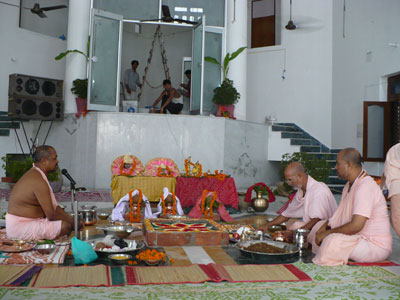
Just after mangala-arati (the early morning ceremony that glorifies the eternal pastimes of Sri Sri Radha-Krsna and thus invokes and auspicious day) on the next day, the thunderous sound of drums announced the arrival of the local band, waiting to accompany the devotees in a parade to the Ganges, to collect water for the ceremony of bathing the new temple Deities.
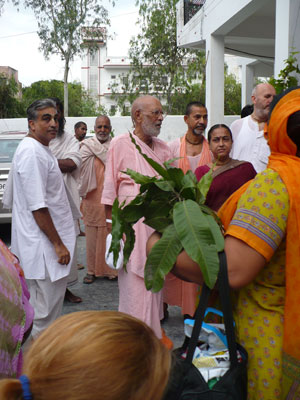
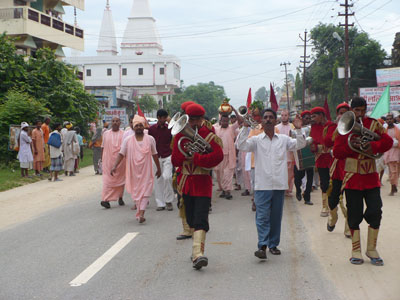
Upon returning, the devotees began kirtana, and made all preparations for the Deity installation. Around 10 am, Srila Narayana Maharaja joined the festivities. Mr. Somnath and his family welcomed Srila Maharaja by washing his feet and performing guru-puja. Then, all sat down and the Deities were brought out of the altar room for their bathing ceremony.
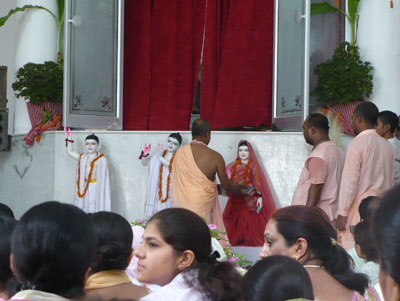
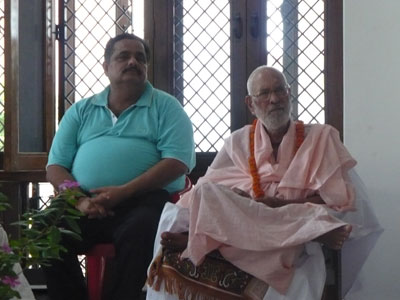
After the bathing ceremony, Srila Maharaja lead the devotees in the arati of Sri Sri Radha-Madhava and Sriman Mahaprabhu.
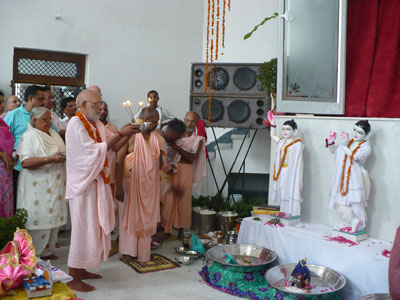
The Deities then returned to the altar room, where, behind closed doors, they were dressed in new outfits and offered a feast
In the meantime, Srila Narayana Maharaja gave class in Hindi. He started by telling some of the pastimes that took place in Haridwar. He said it is the place where Daksa, the father-in-law of Lord Siva, used to live. Daksa performed a large fire sacrifice here, but he did not invite Lord Siva. Sati, Lord Siva’s wife, desired to attend her father’s fire sacrifice anyhow, even without invitation. Therefore she came here, to Haridwar. Seeing her father’s disrespect towards her husband, she became very angry, and by yogic meditation she gave up the body her father had given her – she left in a blazing fire, by meditating on the fiery elements within her body.
Srila Maharaja explained that Haridwar is also the place where, at the beginning of Kali-yuga, Sri Narada Muni met Bhakti-devi and her two sons, Vidya and Vairagya. Bhakti-devi looked very old and was crying over her two sons, who were lying on the ground as if dead. Narada Muni advised Bhakti-devi to go to Vrndavana.
Srila Maharaja said that there are many mayavadis (impersonalists) present in Haridwar. They worship many Deities, mainly for material benefit. He said that devotees, however, worship God with only one purpose: to attain bhakti – devotion. We should think how we can make our present life successful. Only in the human form of life can we think about these things; animals cannot. We should therefore use this life to do bhajana, worship of and devotion to the Supreme Personality of Godhead; not for eating fish and onions. We may be young now, but old age will surely come, so one must do bhajana and chant Hare Krsna.
Srila Maharaja then indicated to Krsna dasa brahmacari to begin kirtana, and to Sripad Tirtha Maharaja to begin the fire sacrifice to celebrate the installation of the Deities.
After that it was time for noon-arati, at which time Sri Sri Radha-Madhava and Mahaprabhu gave their darsana to all present.
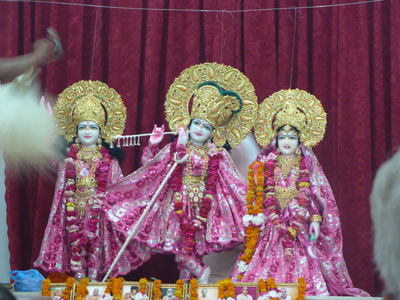
After arati, all the guests and devotees were offered a prasadam feast, and new cloth (dhotis and saris) was distributed to all.
In the evening, Srila Maharaja again gave class. He began by saying that the festival had been very successful, and that all present had been properly honored according to their qualification. He then requested Sripad Rasananda prabhu, Sripad Tirtha Maharaja, Sripad Sagar Maharaja and Sripad Madhava Maharaja to speak on how the Deity is not just a statue made from stone or wood. The speakers gave various examples of how, in past histories, the Deities reciprocated with Their devotees. Srila Narayana Maharaja himself told the pastime of how Srila Sanatana Gosvami found the Deity of Madana-mohana, and how he used to talk with Him.
Srila Maharaja ended by saying that some people claim that God does not have a form. But how is this possible? Can we have something more than God? If He does not have a form, how is it possible that we have forms? People who say such things cannot claim to be learned in theological philosophy.
On the morning of August 20th, Srila Maharaja traveled from Haridwar to Delhi. On the evening of August 22 he celebrated Jhulan-yatra in his Delhi temple in Janaka-puri, and on the morning of August 23rd he continued to Mathura and Vrndavana for the celebrations of the Jhulana-yatra festival (the swing festival), the disappearance day of Srila Rupa Gosvami (August 25th) and the appearance day of Lord Balarama (August 28th).
Editorial Advisors: Pujyapad Madhava Maharaja, Sripad Brajanath dasa and Sri Prema Prayojana dasa
Reporter: Janaki dasi
Translator of the excerpts of Srila Maharaja’s classes: Karuna-mayi dasi
Proofreader: Krsna-kamini dasi
Photographers: Sulata dasi and Janaki dasi
Editor: Syamarani dasi
HTML: Bhutabhavana dasa
![[BVML Home Page]](../../grfx/bml_logo.gif)
